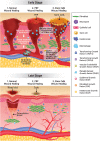Early Intervention with Highly Condensed Adipose-Derived Stem Cells for Complicated Wounds Following Filler Injections
- PMID: 27102776
- PMCID: PMC4870297
- DOI: 10.1007/s00266-016-0636-7
Early Intervention with Highly Condensed Adipose-Derived Stem Cells for Complicated Wounds Following Filler Injections
Abstract
Background: A rise in cosmetic procedures has seen the use of fillers become more prevalent. Complications resulting from use of fillers have prompted introduction of various medical and surgical interventions. Recently, stem cell therapies have become more widely used as a new treatment option for tissue repair and regeneration.
Methods: We utilized adipose-derived stem cells (ASCs) for tissue regeneration in patients with filler-related complications such as necrosis. All 12 patients were treated with ASCs and some patients had additional treatment. After relief of symptoms, wound surface area was compared in terms of pixel numbers and scar condition was evaluated using the Vancouver Scar Scale (VSS).
Results: In general, we achieved satisfactory resolution of filler-related complications in a short period of time without serious side effects. The average number of days from stem cell treatment to symptom relief was 7.3 days. The proportion of wound surface area from photographic record was 4.39 % before treatment, decreasing considerably to 1.01 % following treatment. Last, the VSS showed almost all patients scored below 3, with two patients receiving scores of 7 and 8; the average score was 2.78 (range from 0 to 8).
Conclusions: ASCs are a new treatment option for post-filler injection wounds such as necrosis. Using stem cells, we were able to obtain satisfactory results in a short period of time without complications requiring surgical procedures. We suggest stem cell injections could be used as the first option for treatment of complications from filler injections.
Level of evidence v: This journal requires that authors assign a level of evidence to each article. For a full description of these Evidence-Based Medicine ratings, please refer to the Table of Contents or the online Instructions to Authors www.springer.com/00266 .
Keywords: Adipose-derived stem cells; Filler complication; Necrosis; Tissue repair.
Figures





Similar articles
-
Impending Facial Skin Necrosis and Ocular Involvement After Dermal Filler Injection: A Case Report.Aesthetic Plast Surg. 2017 Oct;41(5):1198-1201. doi: 10.1007/s00266-017-0898-8. Epub 2017 May 31. Aesthetic Plast Surg. 2017. PMID: 28567474
-
Clinical Impact of Highly Condensed Stromal Vascular Fraction Injection in Surgical Management of Depressed and Contracted Scars.Aesthetic Plast Surg. 2018 Dec;42(6):1689-1698. doi: 10.1007/s00266-018-1216-9. Epub 2018 Sep 6. Aesthetic Plast Surg. 2018. PMID: 30191279
-
Preventing the Complications Associated with the Use of Dermal Fillers in Facial Aesthetic Procedures: An Expert Group Consensus Report.Aesthetic Plast Surg. 2017 Jun;41(3):667-677. doi: 10.1007/s00266-017-0798-y. Epub 2017 Apr 14. Aesthetic Plast Surg. 2017. PMID: 28411354 Free PMC article. Review.
-
Treatment of Soft Tissue Filler Complications: Expert Consensus Recommendations.Aesthetic Plast Surg. 2018 Apr;42(2):498-510. doi: 10.1007/s00266-017-1063-0. Epub 2018 Jan 5. Aesthetic Plast Surg. 2018. PMID: 29305643 Free PMC article. Review.
-
Temporary blindness after an anterior chamber cosmetic filler injection.Aesthetic Plast Surg. 2015 Jun;39(3):428-30. doi: 10.1007/s00266-015-0477-9. Epub 2015 Apr 1. Aesthetic Plast Surg. 2015. PMID: 25828586
Cited by
-
Managing intravascular complications following treatment with calcium hydroxylapatite: An expert consensus.J Cosmet Dermatol. 2020 Nov;19(11):2845-2858. doi: 10.1111/jocd.13353. Epub 2020 Mar 17. J Cosmet Dermatol. 2020. PMID: 32185876 Free PMC article.
-
Tissue Source and Cell Expansion Condition Influence Phenotypic Changes of Adipose-Derived Stem Cells.Stem Cells Int. 2017;2017:7108458. doi: 10.1155/2017/7108458. Epub 2017 Aug 23. Stem Cells Int. 2017. PMID: 29138638 Free PMC article.
-
A Systematic Review of Autologous Fat Grafting in the Treatment of Acute and Chronic Cutaneous Wounds.Plast Reconstr Surg Glob Open. 2020 May 18;8(5):e2835. doi: 10.1097/GOX.0000000000002835. eCollection 2020 May. Plast Reconstr Surg Glob Open. 2020. PMID: 33154876 Free PMC article.
-
Protocol for a systematic review of autologous fat grafting for wound healing.Syst Rev. 2018 Jul 18;7(1):99. doi: 10.1186/s13643-018-0769-7. Syst Rev. 2018. PMID: 30021622 Free PMC article.
-
Another face of dermal fillers.Postepy Dermatol Alergol. 2020 Oct;37(5):651-659. doi: 10.5114/ada.2019.82859. Epub 2019 Feb 11. Postepy Dermatol Alergol. 2020. PMID: 33240002 Free PMC article. Review.
References
-
- Yoshimura K, Shigeura T, Matsumoto D, Sato T, Takaki Y, Aiba-Kojima E, Sato K, Inoue K, Nagase T, Koshima I, Gonda K. Characterization of freshly isolated and cultured cells derived from the fatty and fluid portions of liposuction aspirates. J Cell Physiol. 2006;208(1):64–76. doi: 10.1002/jcp.20636. - DOI - PubMed
MeSH terms
Substances
LinkOut - more resources
Full Text Sources
Other Literature Sources
Medical
Research Materials

